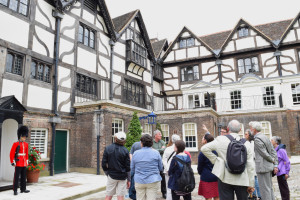On 4 July, a group of 24 Friends of the IHR and interested members of the public gathered for a guided tour of the Tower of London. Every summer the Friends organise a visit to some place of historical interest and this year proved an exceptional outing. Once assembled at the Middle Drawbridge, the party split into two groups, for simultaneous tours, and off we went.
Starting with Dr Alden Gregory at the helm, my group went first to the Queen’s House, nestled in the southwest corner of the Tower grounds. Dr Gregory, a Buildings Curator with Historic Royal Palaces, began by dispelling the myth, perpetuated by the Beefeaters, that the house was a wedding present built for Anne Boleyn. Dendrochronology suggests the house was built around 1539-40, after her death, and we know instead that it served as the lodging for the Lieutenant of the Tower. Today, it is the private residence of the Constable of the Tower of London. After noting the restoration work to the timber framing and casement windows to revive the original, pre-Great Fire Tudor appearance, we ventured inside and into the Bell Tower. This empty stone chamber was once adjacent to the Thames, and the cell of Sir Thomas More.
We then made our way upstairs to the Great Hall. The room was originally twice as high until a mid-level floor was installed in 1607, and the excessively timbered ceiling was only rediscovered and revealed in the 1960s during repairs to a water leak. The most impressive features, however, are a large wall monument and a portrait bust of King James VI. Not just a hall for eating and entertaining, the space also served as an interrogation room for notable prisoners (though the torture took place elsewhere).
Most famously, Guy Fawkes and his co-conspirators were questioned here; the red, white, and black marble and alabaster wall memorial is fixed as a testament to the triumph of the inquisitors and condemnation of the accused. It dates to 9 October 1608, making it perhaps the oldest commemorative interior plaque of its kind. To its right, the bust of the king served to intimidate prisoners as they entered the hall and to represent the royal presence during interrogations.
Heading outside, the groups re-assembled, swapped tour guides, and Dr Jane Spooner, also a Buildings Curator, led our half of the party to the Byward Tower. Situated on the interior side of the main visitor entrance bridge, this thirteenth century fortification was a principal point for defence of the Tower. As with the Queen’s House, this area is normally closed to the public, and there was something very exclusive and satisfying about shutting the door behind us as we ascended the spiral stairs. At the top, Dr Spooner explained that in the mid-fourteenth century the space would have housed the King’s Exchange, part of the Royal Mint. The fine appointments that decorate the room—red striping on the stone walls, a large fireplace, and a tiled pavement—were befitting of this distinguished occupant.
Crossing the hall, past the wooden mechanism of the inner portcullis, we entered a slightly larger, timber-framed room, resplendent with a fourteenth century wall painting. The scene is brought to life with an array of expensive green, red, and blue pigments and gold leaf. It depicts on one side St John the Baptist and the Virgin Mary, and on the other St John the Evangelist and the archangel Michael, holding the scales weighing Christ’s soul in judgement. The figure of Christ on the cross, originally over the mantelpiece, was replaced with a Tudor rose in the sixteenth century when a new fireplace was installed. An imposing beam running the length of the room bears more green and gold painting, of birds, lions, and fleurs-de-lis. There is evidence that paintings of angels once existed on the north wall, as late as the 1950s, but almost no trace now survives.
The groups came back together a final time for some refreshments in the Great Hall of the Queen’s House. What a marvellous treat to sit where Guy Fawkes may have sat, though thankfully with some lovely tea and scones instead of an inquisitorial squad. There was just enough time left in the day to make a quick visit of the armouries or the crown jewels. The outing was a great success for all, and a particularly splendid introduction for those who had never been to the Tower, like yours truly.



